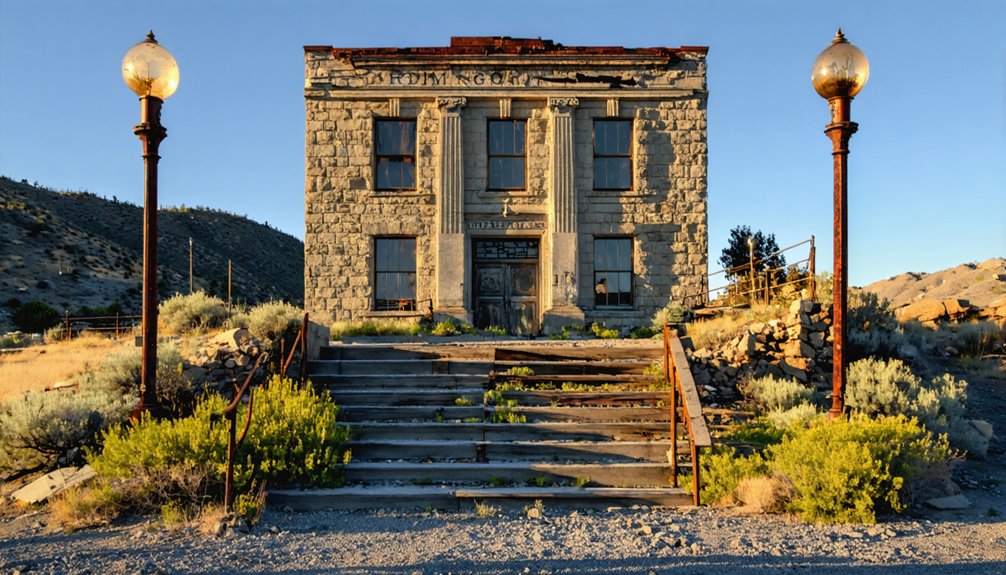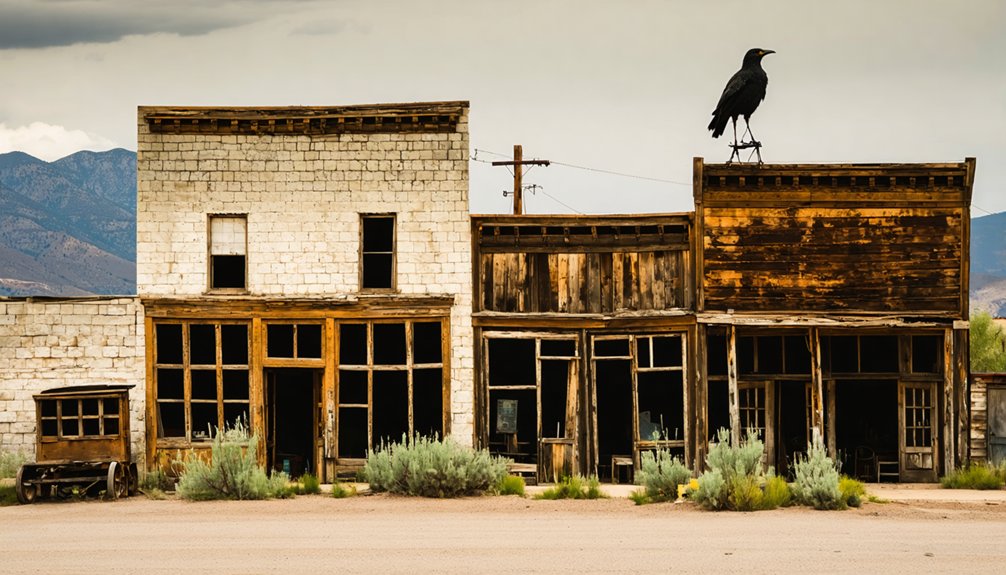You’ll find Agua Fria‘s remains along Highway 140 in Mariposa County, where this significant Gold Rush settlement emerged after Mexican miners discovered gold in 1849. As the county’s first seat, it flourished with dozens of stores, a brewery, and a multicultural population until the mid-1850s. The town declined rapidly when gold yields diminished, and a devastating 1866 fire sealed its fate. Today, California Historical Landmark #518 marks this once-bustling hub’s rich narrative.
Key Takeaways
- Agua Fria was an early California Gold Rush settlement established in 1849 and served as Mariposa County’s first seat until 1851.
- The town flourished with numerous stores, trading posts, and entertainment venues serving thousands of miners during its peak years.
- Cultural diversity characterized the settlement, with Mexican, Chinese, and other ethnic groups participating in mining and commerce.
- A devastating fire in 1866 destroyed most of the town’s structures, leaving only one surviving home.
- Today, Agua Fria is commemorated as California Historical Landmark #518, with only historical markers remaining along Highway 140.
The Birth of a Gold Rush Settlement
When gold was discovered along Agua Fria Creek in May 1849 by Sonoran miners under Alexander Godey’s direction, it marked the beginning of one of Mariposa County‘s earliest and most significant Gold Rush settlements.
The discovery’s timing coincided with California’s broader gold fever, positioning Agua Fria as a strategic hub in the Mother Lode‘s southern region.
Agua Fria emerged as a vital southern outpost during California’s gold rush, perfectly situated within the Mother Lode’s rich terrain.
You’ll find that early settlers quickly transformed this creek-side location into a bustling community, capitalizing on its advantageous position near Carson Creek and other gold-bearing waterways.
The Southern and Central Miwok tribes had called this region home for thousands of years before the rush for gold forever changed their way of life.
The settlement’s importance grew rapidly, earning it the distinction of becoming Mariposa County’s first seat in 1850.
The multicultural mix of miners, including the original Sonoran prospectors, shaped the town’s early character while displacing the indigenous Miwok people who’d previously inhabited the area.
The area’s development paralleled that of nearby town of Mariposa, which was established by John Charles Fremont during the same period.
A Thriving Commercial Hub
You’ll find a remarkable transformation in Agua Fria during 1850-1851, as James D. Savage’s trading post catalyzed rapid commercial growth in this Gold Rush boomtown.
The establishment of multiple supply stores, gambling halls, and recreational venues created a complex commercial ecosystem serving hundreds of American and Mexican miners. To avoid confusion with other locations, historical records specifically refer to this site as Agua Fria, California to distinguish it from similarly named places.
The town’s designation as the first Mariposa County seat amplified its importance as a regional hub, with approximately a dozen stores eventually operating at its peak to serve the mining community. The town’s prosperity ended when a devastating fire in 1866 destroyed the entire settlement.
Trading Posts Emerge
The emergence of trading posts in Agua Fria marked a pivotal transformation from a simple mining settlement into a vibrant commercial hub during the early 1850s.
James D. Savage’s strategic placement of trading posts along major travel routes revolutionized supply chain dynamics in the region. You’ll find his most significant post established where Agua Fria Creek meets the Mariposa River, near an old stone fort.
The trading post logistics reflected careful planning, with locations chosen to maximize accessibility for miners while maintaining security. Savage successfully employed Indian trading partners to help operate his posts, building strong relationships with local tribes.
These posts didn’t just serve as supply centers – they became essential nodes in the region’s economic network. Through sophisticated bartering systems and gold dust transactions, Savage’s operations facilitated trade between remote mining camps and larger markets, connecting Agua Fria to San Francisco’s broader commercial sphere. Among the most successful establishments was Church’s store, which served an impressive three thousand Chinese miners in the area.
Gold Rush Business Boom
As thousands of gold-seeking migrants flooded into California during 1849-1850, Agua Fria rapidly transformed into a bustling commercial center that capitalized on its strategic location near Sierra foothill gold deposits.
Local merchants developed sophisticated business strategies to meet miners’ demands, establishing resilient supply chains that connected the remote town to major hubs like San Francisco. The skyrocketing prices of goods forced merchants to constantly adjust their rates to maximize profits. Some enterprising traders were among the rare four percent who found significant financial success in the Gold Rush era.
You’ll find that successful entrepreneurs like Robert Brownlee implemented these key commercial adaptations:
- Accepting gold dust as direct payment to integrate miners’ earnings
- Charging premium prices for scarce essential goods
- Diversifying services through blacksmith shops and boarding houses
- Establishing freight networks to guarantee consistent inventory
The town’s designation as Mariposa County seat from 1850-1854 further concentrated economic activity, making Agua Fria the region’s primary commercial hub until declining gold yields sparked its eventual downturn.
Life in Early Agua Fria
In early Agua Fria, you’d find Mexican miners working their gold claims during daylight hours while merchants kept their dozen stores bustling with prospecting supplies and basic goods.
You could witness the town’s vibrant multicultural atmosphere through the mix of languages and customs, as Sonoran miners interacted with merchants and travelers at the local hotel and gathering spots. The town’s strategic location near cold water springs made it an appealing spot for settlement and development.
At night, you’d see the gambling halls come alive with games of Three Card Monte and Faro, while others sought entertainment at the billiard room or bowling alley, creating a frontier social scene typical of Gold Rush settlements. The town thrived as the first county seat from 1850 to 1851, bringing additional prominence to the community.
Daily Mining Camp Routines
Life in Agua Fria’s mining camps revolved around a demanding daily schedule dictated by daylight hours and mining operations.
You’d find yourself rising at dawn to begin your mining routines, facing daily challenges from harsh working conditions and physical demands.
- You’d start your day with a simple breakfast of beans, bacon, and coffee before heading to the mines or creek beds for placer mining.
- Working hours stretched from sunrise to sunset, whether you’re operating the 6-stamp quartz mill or digging in hard rock tunnels.
- During breaks, you’d gather at the camp’s social spots – the hotel, billiard room, or monte hall.
- Evening activities centered around the camp’s wooden structures, where you’d find rest or entertainment before starting another grueling day.
Multicultural Social Scene
While miners sought gold in Agua Fria’s rich creek beds, the town’s social fabric wove together a complex tapestry of American, Mexican, European, and Chinese immigrants.
You’d have found distinct cultural zones where different groups maintained their traditions, particularly in the Chinese quarter of Lower Agua Fria. Cultural exchanges flourished in the marketplace, where merchants of various backgrounds traded goods and services essential to mining life.
Community dynamics weren’t always harmonious – tensions existed between settlers and Native Miwok people, leading to militia formations.
Yet survival in the isolated settlement demanded cooperation. You’d have witnessed diverse languages mingling at the natural springs, where residents gathered daily.
The town’s position as the first county seat fostered administrative cooperation across ethnic lines, even as social segregation persisted in living arrangements and cultural practices.
Entertainment and Commerce
The bustling social life of Agua Fria extended beyond its multicultural neighborhoods into a vibrant entertainment and commercial district.
You’d find a thriving gambling culture centered around faro and three card monte tables, while social gatherings flourished at the town’s hotel, billiard room, and bowling alley.
The commercial landscape featured crucial services that supported both miners and residents.
- A dozen stores, including Egenhoff and Bertken’s establishments, provided necessary goods
- The Gossner & Co. brewery served the community until the 1866 fire
- An express office and post office (est. 1851) maintained essential communications
- Mining operations, including a 6-stamp quartz mill, drove the local economy
The town’s entertainment venues and commercial enterprises reflected its peak prosperity, offering residents both practical services and leisure activities that defined frontier life.
Political Power and County Governance

From February 1850 to November 1851, Agua Fria served as the inaugural county seat of Mariposa County, wielding administrative control over approximately one-sixth of California’s territory.
You’ll find that during this period, the town’s political influence extended across vast stretches of the Sierra Nevada foothills, overseeing critical mining claims and legal proceedings that shaped early California mining law.
Despite its significant jurisdiction, Agua Fria faced substantial governance challenges.
Operating from makeshift administrative buildings, officials struggled to manage the largest county in California with limited infrastructure.
The town’s dozen stores and establishments supported basic governmental functions until mounting logistical difficulties and population shifts prompted the seat’s relocation to Mariposa in 1852, where a permanent courthouse was established by 1854.
The Town’s Dramatic Decline
Mining fortunes reversed sharply for Agua Fria in the mid-1850s as gold yields diminished and prospectors migrated to more promising claims.
Multiple economic factors converged to accelerate the town’s decline, while devastating fires sealed its fate. You’ll find that by 1866, this once-bustling settlement was reduced to a single surviving home.
Economic collapse and devastating fires brought Agua Fria to its knees, leaving just one house standing by 1866.
Key factors in Agua Fria’s demise:
- Loss of county seat status to Mariposa in 1851, diminishing political influence
- Exodus of miners and merchants as gold deposits waned
- Fire impact, particularly the catastrophic 1866 blaze that destroyed 75 structures
- Land ownership complications under Frémont’s estate, preventing reconstruction
Today, you’ll see only grassland where this frontier town once stood, marked by historical plaques along Route 140 as evidence of its dramatic transformation.
Historical Legacy and Modern Remembrance

Despite its physical disappearance, Agua Fria’s historical significance endures through California Historical Landmark #518, established in 1954 by the Native Daughters of the Golden West and reinforced by E Clampus Vitus in 2000.
Today, you’ll find the site along Highway 140, where historical markers serve as tangible reminders of this crucial settlement.
While the town’s physical structures have vanished, cultural preservation efforts keep its legacy alive through educational programs and historical research.
You can explore the area’s rich multicultural heritage, from its Sonoran miners to Chinese settlers, through local historical narratives and guidebooks.
The site continues to function as an essential educational resource, helping you understand California’s dramatic shift from mining camps to established communities during the Gold Rush era.
Frequently Asked Questions
What Indigenous Peoples Lived in the Agua Fria Area Before the Gold Rush?
You’ll find the Southern and Central Miwok indigenous tribes inhabited this region for roughly 4,000 years, establishing settlements of cultural significance through their complex material practices and territorial connections.
How Deep Were the Gold Mines Around Agua Fria?
You’ll find these treasure-seeking passages plunged deep beneath Earth’s surface, with gold mine depths reaching about 1,500 to 1,600 feet through inclined shafts and mining techniques including underground vein extraction.
What Happened to the Residents After the 1866 Fire?
You’ll find that after the fire aftermath, residents scattered to surrounding towns like Mariposa and Mount Bullion, experiencing residential migration as they lacked property rights to rebuild their community.
Are There Any Preserved Artifacts From Agua Fria in Museums Today?
You’ll find limited artifact preservation from Agua Fria, with no dedicated museum exhibitions. Regional museums might house scattered items, but most physical remnants were lost or dispersed through time.
Can Visitors Still See Any Original Building Foundations at the Site?
Through scattered patches of waving grass, you’ll spot a few weathered building foundations, though their preservation is limited. Most remnants are barely visible, making visitor experiences more about imagination than tangible discovery.
References
- https://en.wikipedia.org/wiki/Agua_Fria
- https://www.mariposacounty.org/1620/On-Hold-Narratives
- https://noehill.com/mariposa/cal0518.asp
- https://www.californiahistoricallandmarks.com/landmarks/chl-518
- http://freepages.rootsweb.com/~gtusa/history/usa/ca/agua-fria.htm
- https://westernmininghistory.com/towns/california/agua-fria/
- https://www.ghosttowns.com/states/ca/aguafria.html
- https://www.exploratography.com/blog-49/agua-fria-california-hwy49
- https://www.yosemiteebiking.com/post/mariposa-gold-rush
- https://www.yosemite.com/yosemite-mariposa-county-region/history/



